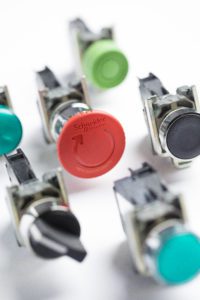As control systems increase in both scale and data-rich sensors, we need a way to ensure that operators can recognise what is important and act to deliver a more efficient control system. In the real world where so many sources of information exist, we use high-impact colors to draw attention. The highest impact colors are red and yellow.
This approach is used to great effect in most sets of business metrics. Colors are often used as performance indicators for tasks to be accomplished. Those that require immediate attention are highlighted in RED, while those with more time to act upon are highlighted in YELLOW. GREEN often indicates resolved tasks. Our eyes are naturally drawn to the metric that needs our action the most.
The same occurs on the road. Important road signs appear with RED borders, while advisory indications appear in YELLOW. General information appears in other more muted colors. Traffic lights too are created with RED (act and stop), YELLOW (consider stopping) and GREEN (do nothing).
RED is used to highlight the need to take immediate action in our business and personal lives. Nonetheless, it often means “stop” on a control system screen. Historically this made some sense, as the only indication of asset status was a small light. A visible red light indicates a device is not working and requires action.
Modern Industrial Process Automation Control systems are significantly more advanced. We know which asset has a fault, the cause of the fault and how to resolve it. We should move to the use of RED from representing inaction to a color driving the immediate action for the operator.
Using RED to highlight inaction results in many red indicators when a process stops. How is an operator with a screen of RED supposed to focus on actual cause? To improve operator efficiency, RED should be used to highlight faults and alarm conditions for assets that have faults and require attention.
Furthermore, assisting operator efficiency requires more than a single color to drive action. Using different colors to highlight the speed at which the operator is required to act enables the operator to focus and prioritise the required actions. The highest priority should be to maintain the process, followed by those which require it to be restarted.
This approach to color is adopted in standards like Situational Awareness. Many customers focus on the grey/white default colors but the key is highlighting these pops of color to focus the operator on action.
If you are looking for a library which can be rapidly be implemented for your project, consider the General Purpose Library offers available for free on Schneider Electric Exchange.
These libraries (for Ecostruxure Control Expert, System Platform or Citect) implement the benefits of Situational Awareness while still allowing a running asset to show green. They are also implemented using the Schneider Electric Modular libraries approach which allows easy customisation and extension to meet your site needs.


